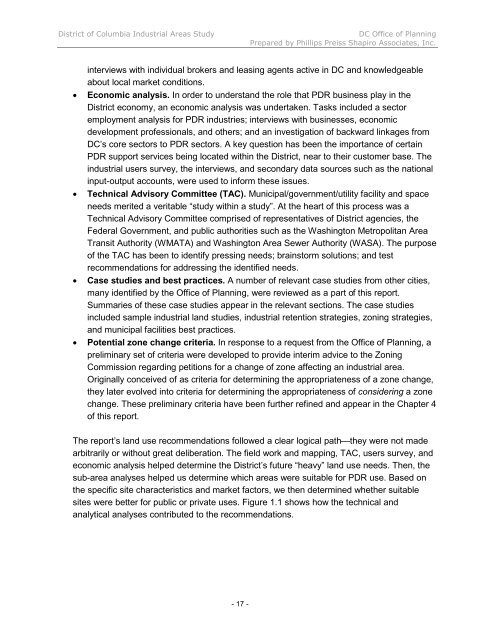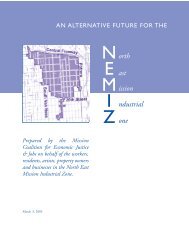INDUSTRIAL LAND IN A POST-INDUSTRIAL CITY District of ...
INDUSTRIAL LAND IN A POST-INDUSTRIAL CITY District of ...
INDUSTRIAL LAND IN A POST-INDUSTRIAL CITY District of ...
Create successful ePaper yourself
Turn your PDF publications into a flip-book with our unique Google optimized e-Paper software.
<strong>District</strong> <strong>of</strong> Columbia Industrial Areas Study DC Office <strong>of</strong> Planning<br />
Prepared by Phillips Preiss Shapiro Associates, Inc.<br />
interviews with individual brokers and leasing agents active in DC and knowledgeable<br />
about local market conditions.<br />
Economic analysis. In order to understand the role that PDR business play in the<br />
<strong>District</strong> economy, an economic analysis was undertaken. Tasks included a sector<br />
employment analysis for PDR industries; interviews with businesses, economic<br />
development pr<strong>of</strong>essionals, and others; and an investigation <strong>of</strong> backward linkages from<br />
DC’s core sectors to PDR sectors. A key question has been the importance <strong>of</strong> certain<br />
PDR support services being located within the <strong>District</strong>, near to their customer base. The<br />
industrial users survey, the interviews, and secondary data sources such as the national<br />
input-output accounts, were used to inform these issues.<br />
Technical Advisory Committee (TAC). Municipal/government/utility facility and space<br />
needs merited a veritable “study within a study”. At the heart <strong>of</strong> this process was a<br />
Technical Advisory Committee comprised <strong>of</strong> representatives <strong>of</strong> <strong>District</strong> agencies, the<br />
Federal Government, and public authorities such as the Washington Metropolitan Area<br />
Transit Authority (WMATA) and Washington Area Sewer Authority (WASA). The purpose<br />
<strong>of</strong> the TAC has been to identify pressing needs; brainstorm solutions; and test<br />
recommendations for addressing the identified needs.<br />
Case studies and best practices. A number <strong>of</strong> relevant case studies from other cities,<br />
many identified by the Office <strong>of</strong> Planning, were reviewed as a part <strong>of</strong> this report.<br />
Summaries <strong>of</strong> these case studies appear in the relevant sections. The case studies<br />
included sample industrial land studies, industrial retention strategies, zoning strategies,<br />
and municipal facilities best practices.<br />
Potential zone change criteria. In response to a request from the Office <strong>of</strong> Planning, a<br />
preliminary set <strong>of</strong> criteria were developed to provide interim advice to the Zoning<br />
Commission regarding petitions for a change <strong>of</strong> zone affecting an industrial area.<br />
Originally conceived <strong>of</strong> as criteria for determining the appropriateness <strong>of</strong> a zone change,<br />
they later evolved into criteria for determining the appropriateness <strong>of</strong> considering a zone<br />
change. These preliminary criteria have been further refined and appear in the Chapter 4<br />
<strong>of</strong> this report.<br />
The report’s land use recommendations followed a clear logical path—they were not made<br />
arbitrarily or without great deliberation. The field work and mapping, TAC, users survey, and<br />
economic analysis helped determine the <strong>District</strong>’s future “heavy” land use needs. Then, the<br />
sub-area analyses helped us determine which areas were suitable for PDR use. Based on<br />
the specific site characteristics and market factors, we then determined whether suitable<br />
sites were better for public or private uses. Figure 1.1 shows how the technical and<br />
analytical analyses contributed to the recommendations.<br />
- 17 -












